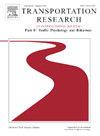人机界面和车辆自动化:文献综述及系统设计、反馈和警报建议
IF 3.5
2区 工程技术
Q1 PSYCHOLOGY, APPLIED
Transportation Research Part F-Traffic Psychology and Behaviour
Pub Date : 2024-10-01
DOI:10.1016/j.trf.2024.08.014
引用次数: 0
摘要
驾驶自动化系统中人机界面(HMI)的有效性部分取决于它如何向驾驶员发出警报和请求--它必须快速、充分地引导驾驶员完成驾驶任务。虽然对人机界面的设计有很多研究,但必须综合考虑独特的关联和有意义的关系,才能为车辆自动化提供指导。本研究的目的是:(a) 回顾和综合与驾驶自动化系统的干预请求 (RTI) 相关的人机界面设计方面的现有研究和指导;(b) 提出一套清晰而全面的建议,为未来的系统开发和实施提供参考。按照 PRISMA 指南进行了全面的文献检索和筛选,共审查了 93 篇文章。综述结果表明,多模式警报非常突出、有用且有效。文献中报道的许多人机界面都大同小异,都遵守了完善的人机界面设计准则。一小部分人机界面则证明了其独特而创新的设计原则。综上所述,本研究为驾驶自动化系统中的人机界面设计提出了 10 项建议,从听觉警报与视觉警报的实用性到警报的时间、灵敏度和位置,不一而足。本文章由计算机程序翻译,如有差异,请以英文原文为准。
Human-Machine interfaces and vehicle Automation: A review of the literature and recommendations for system Design, Feedback, and alerts
The effectiveness of the human–machine interface (HMI) in a driving automation system is based, in part, on how it issues alerts and requests to the driver—it must quickly and sufficiently orient the driver to the driving task. While much research on the design of HMIs exists, unique associations and meaningful relationships must be considered collectively to offer guidance for vehicle automation. The purpose of the current study was to: (a) review and synthesize existing research and guidance on HMI design as it related to requests to intervene (RTI) for driving automation systems and (b) propose a clear and comprehensive set of recommendations that could inform future system development and implementation. A thorough literature search and selection process was followed the PRISMA guidelines and resulted in the review of 93 articles. The review’s outcome indicates multimodal alerts are prominent, useful, and effective. Many of the HMIs reported in the literature were similar in that they abided by well-established HMI-design guidelines. A small subset of HMIs established evidence for distinct and innovative design principles. Taken together, this study proposed 10 recommendations for HMI design in driving automation systems, ranging from the utility of auditory versus visual alerts to the timing, sensitivity, and location of alerts.
求助全文
通过发布文献求助,成功后即可免费获取论文全文。
去求助
来源期刊
CiteScore
7.60
自引率
14.60%
发文量
239
审稿时长
71 days
期刊介绍:
Transportation Research Part F: Traffic Psychology and Behaviour focuses on the behavioural and psychological aspects of traffic and transport. The aim of the journal is to enhance theory development, improve the quality of empirical studies and to stimulate the application of research findings in practice. TRF provides a focus and a means of communication for the considerable amount of research activities that are now being carried out in this field. The journal provides a forum for transportation researchers, psychologists, ergonomists, engineers and policy-makers with an interest in traffic and transport psychology.

 求助内容:
求助内容: 应助结果提醒方式:
应助结果提醒方式:


